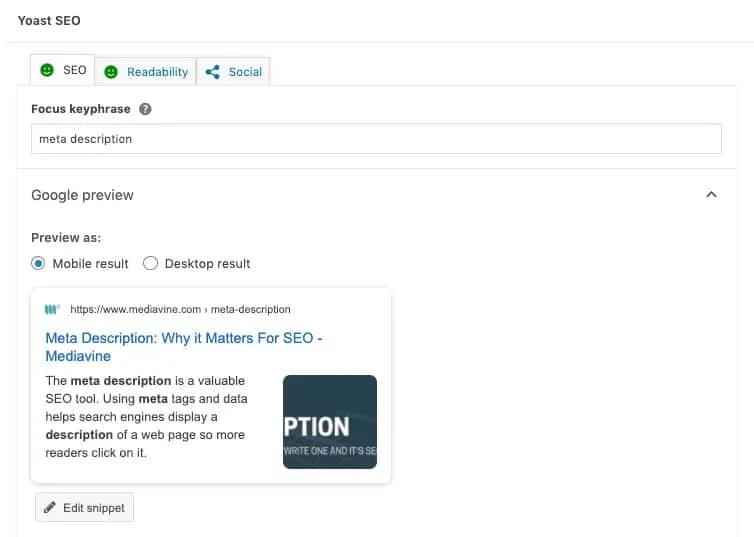Meta Description: Why it Matters For SEO


If you’re familiar at all with SEO, chances are you’ve heard of the meta description. What you might be surprised to learn is how to write a great one — and that this still matters in 2020.
The meta description is a hidden HTML attribute at the top of your web page. It might seem dated to those who have been at this awhile, but Google still recommends you use these.
Google definitely still parses them, too. So today, we’re going to talk about how a meta description is used, its impact on your SEO and traffic and how to produce the best ones possible.
Also known as meta tags, meta descriptions are HTML tags designed specifically for robots or computers to parse. In other words, they do not appear on the page itself for humans to actually read.
These tags can be seen if you view the HTML source of a page, but otherwise you won’t see them.
Each meta tag has both a name and a content parameter. For a meta description, the name is “description” and its content will be a unique description you should write for each page.
Meta tags should appear at the top of your HTML, or in the <head> section. For example:
<html>
<head>
<title>...</title>
<meta name="description" content="I am a fantastic meta description." />
...
</head>
...
</html>
With the technical details out the way, here is the more important question: What is this even for?
First, we need to make it clear that by all accounts, meta descriptions will not affect your rankings here in 2020. Whatever your keyword density is, it won’t help or hurt you re: SERPS (Search Engine Result Pages).
So why write one? First, because Google flat out asks you to in their SEO Starter Guide.
That’s reason enough for us, but additionally, as we’ve mentioned in previous SEO articles, it’s not about just search rankings, but getting users to click on your search results and visit your site.
It’s important to note that Google uses your meta tags as a hint.
Google won’t always display your handwritten description in search results, and may choose to pull another snippet of text from the rest of your content, should they feel it better matches the search query.
However, if you’re following the sage advice from our keyword prominence article, and the user is searching for that keyword or phrase, chances are good that Google will in fact use this section.
If they’re searching for different long-tail keywords than you happened to be targeting with your page and meta description, that’s fine. Google will likely excerpt a different section of text where you used that phrase.
The bottom line (as we’ve said in just about every SEO article to date) is not to stress too much over this. The goal is to write a good teaser for instances in which Google does select your meta tag.
If they don’t pick that, it’s fine. Just give them the chance to!

Let’s head to — where else — our friends at Google for advice.
The ideal length for meta descriptions is… whatever you want. Google tells you it should be a couple sentences or a paragraph in length, but that if you exceed that, this is 100% fine.
There is no character limit. Google will truncate it to fit whatever device width the user is browsing on, so feel free to write a longer description if you think that’s the best option.
The ideal formatting for your meta description is… also whatever you like! Google explicitly says it doesn’t even need to be in sentence format. In fact, they give examples on using structured data.
Just like the information Create outputs in Schema.org, you can list things like diets, number of ingredients or tools used to cook.
But remember — don’t repeat structured data Google already pulls from Schema like calories, cook time, ratings in recipes, etc.
The meta description allows you to choose your own format. Your only goal is to entice readers to click on your content with it.
In order to make them do that, think back to our keyword proximity post. Make sure to use your focus keywords together in the description, so Google will bold the search query and help your results stand out.
Remember, this is also going to appear directly below your page title in the results, so as Google says, don’t just repeat the word directly below it. Have the two pair nicely together.
Let’s go for an example, and use this post itself.
Our page title is, “Meta Description: Why it Matters For SEO,” as you can see. So what I want is a description that pairs nicely with that, but is unique and useful to both search engines and readers.
Here goes nothing:
The meta description is a valuable SEO tool. Using meta tags and data helps search engines display a description of a web page so more readers click on it.
Not bad. Original and concise, with keyword usage that gives Google a strong idea of what we’re going for and what to bold for potential readers. Good job, me.
Now, to make this the most, well, meta thing ever, I’m going to enter the two sentences I just wrote into Yoast as its official meta description. (More on Yoast’s role in this shortly.)
Again, we’re heeding Google’s words when we tell you that using duplicate meta descriptions across multiple pages will trigger a Google Search Console warning.
Google explicitly says to give each page a different one if you do a “site: search” on your domain.
In other words, don’t plug a catchall meta description into various pages. It’s better to have no meta description and let Google pick one out for you than to reuse a generic one.
If you have pages that are just generated by the computer, like archive pages that would be challenging to create unique meta descriptions for, just don’t write one.
Running an e-commerce section of your site? Then these kinds of pages will likely be numerous.
If you can construct ones that are programmatically generated, have unique content and are clickable? Go for it. If not, again, just leave it blank and let Google do its thing.
However, for category pages you may be using as cornerstone content or individual post pages that you hope and expect to rank on, it’s 100% worth your time to handcraft a meta tag.

If you’re running WordPress, then you’re going to need a third-party SEO tool, such as the popular Yoast plugin, to be able to easily customize your meta description.
As I mentioned earlier, I just entered the meta description for this page into Yoast, which was super easy. (And came in just under the suggested, but not mandatory, character limit.)
With another CMS, you’ll have to check the documentation. It’s not always obvious, but it’s worth researching and doing. See the very top of this page for a hard-coded example.
In any case, meta descriptions make up a large percentage of search engine results overall. Don’t take them for granted. Take advantage of the valuable screen real estate Google is giving you.
Stay up to date with the latest from Mediavine
 Eric Hochberger
Eric Hochberger
Google recently announced that any publisher passing the new Page Experience algorithm will be considered for the top story carousels in Google News. This shift comes after years of Google …
 Eric Hochberger
Eric Hochberger
Whether it’s for SEO or monetization purposes, we always encourage publishers to update old content. We’ve discussed at length how specifically to update content to improve RPM and optimize for …
 Eric Hochberger
Eric Hochberger
Today on the Mediavine blog, we’re throwing it back to 2017, famously known to SEO experts across the web as the Year of the Parboil. It was never actually known …